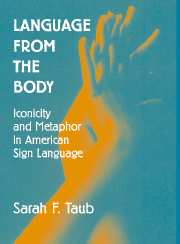Book contents
- Frontmatter
- Contents
- List of Figures
- Acknowledgments
- 1 A Glimpse of the Material
- 2 Motivation and Linguistic Theory
- 3 Iconicity Defined and Demonstrated
- 4 The Analogue-Building Model of Linguistic Iconicity
- 5 Survey of Iconicity in Signed and Spoken Languages
- 6 Metaphor in American Sign Language: The Double Mapping
- 7 Many Metaphors in a Single Sign
- 8 The Vertical Scale as Source Domain
- 9 Verb Agreement Paths in American Sign Language
- 10 Complex Superposition of Metaphors in an American Sign Language Poem
- 11 The Future of Signed-Language Research
- Appendix 1 Glossing Conventions
- Appendix 2 Translation of “The Treasure”
- References
- Index
2 - Motivation and Linguistic Theory
Published online by Cambridge University Press: 16 October 2009
- Frontmatter
- Contents
- List of Figures
- Acknowledgments
- 1 A Glimpse of the Material
- 2 Motivation and Linguistic Theory
- 3 Iconicity Defined and Demonstrated
- 4 The Analogue-Building Model of Linguistic Iconicity
- 5 Survey of Iconicity in Signed and Spoken Languages
- 6 Metaphor in American Sign Language: The Double Mapping
- 7 Many Metaphors in a Single Sign
- 8 The Vertical Scale as Source Domain
- 9 Verb Agreement Paths in American Sign Language
- 10 Complex Superposition of Metaphors in an American Sign Language Poem
- 11 The Future of Signed-Language Research
- Appendix 1 Glossing Conventions
- Appendix 2 Translation of “The Treasure”
- References
- Index
Summary
ARBITRARY, PREDICTABLE … OR MOTIVATED?
Let us look at the impact that metaphor and iconicity have on linguistic theory.
As we have seen, iconic linguistic items are related to their meanings through physical resemblance. We should note, however, that there are many different possible iconic representations of a single visual or auditory image; for example, one could represent different parts of the image, use different scales or perspectives, or preserve different levels of detail. As Klima and Bellugi (1979) observed, the signs meaning tree in ASL, Danish Sign Language, and Chinese Sign Language are all equally iconic but different in form: in ASL tree (see Fig. 3.1), the hands and forearms are positioned to resemble a tree growing out of the ground; the Danish equivalent uses the hands to trace the outline of a tree's branches and trunk, top to bottom; and the Chinese sign meaning tree uses two curved hands to trace the outline of a tree trunk, from the ground up.
Clearly, the meaning tree and the associated visual image do not determine the signs' forms, as they are all different – but neither are the forms unrelated to the meaning. Instead, the forms all bear different types of physical resemblance to the image of a tree. The nature of these forms, given their meaning, is neither arbitrary nor predictable but rather motivated.
- Type
- Chapter
- Information
- Language from the BodyIconicity and Metaphor in American Sign Language, pp. 8 - 18Publisher: Cambridge University PressPrint publication year: 2001



